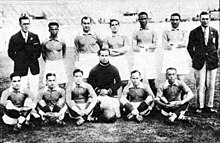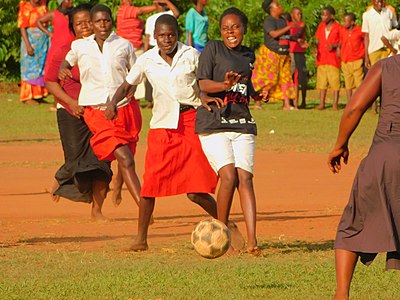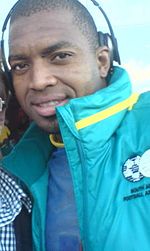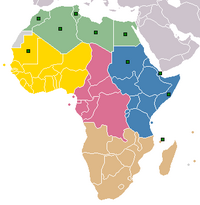Portal:Football in Africa
Introduction
Football is the most popular sport in Africa. Indeed, football is probably the most popular sport in every African country, although rugby and cricket are also very popular in South Africa. (Full article...)
This section may be unbalanced towards certain viewpoints. (October 2022) |

Selected article -

The Angola national football team (Portuguese: Seleção nacional de futebol de Angola) represents Angola in men's international football and is controlled by the Angolan Football Federation. Nicknamed Palancas Negras (Black Sable antelopes), the team is a member of both FIFA and the Confederation of African Football (CAF).
Angola reached its highest FIFA ranking of 45th in July 2000. Their greatest accomplishment was qualifying for the 2006 World Cup, their only World Cup to date.
Selected biography -
Khune started out as a defender when he arrived for trials at Chiefs in 1999, but assumed the gloves by chance after he experienced chest problems during a junior game and found himself being reduced to a ball boy. Diving for balls that had missed the target he caught the attention of youth coach Terror Sephoa who converted him to a goalkeeper. In 2004 he was promoted to the first team.
After three years of waiting to get any game time, Khune finally got his opportunity in the early stages of the 2007–08 season after the departure of number one goalkeeper Rowen Fernandez to German club Arminia Bielefeld. With the experienced Emile Baron often plagued by injuries, Khune was made number one by then Chiefs coach Muhsin Ertugral. His first season in the top-flight was highly successful as several match-winning displays for his side earned him a host of individual awards with Chiefs having the best defensive record in the league conceding only 19 goals in 30 games.
In October 2011, Khune was assigned as captain replacing Jimmy Tau. The 2012-13 season was arguably his best with Khune leading his side to a league and cup double. He was also voted into Goal.com's Goal50 which is a list of the best players of 2013. He was ranked 45th ahead of Fernandinho, Robbie Keane and Frank Lampard and behind Andrea Pirlo, Roman Weidenfeller, Victor Wanyama and James Rodríguez who were all ranked from 40 to 50. He made his 200th appearance for Chiefs against Mpumalanga Black Aces in 2014.
Selected image -
 |
This is a football match between women and girls in Muguluka, Jinja, Uganda during the Women's Day Celebration event. The women beat the girls 1-0.
Subcategories
Related portals
More sports portals
WikiProjects
Related task forces and sub-projects
African football task force
WikiProject Africa • WikiProject Football
WikiProject Football task forces and sub-projects
 | |
| Wikipedia ads | file info – #250 |
Topics
Open tasks

- Expand stubs: Competitions in Africa • Organizations
- Expand club articles of teams from Africa.
- Expand biographies of Africans involved in football.
- Create: Requested articles • Most wanted football articles • Requested general football articles
- Add: Infoboxes • Images (General requests, Requested images of people)
- Review: articles currently under review
- Assess: Assessment requests • Assess an article
- Revert vandalism on this portal and on African football articles
- Assist in maintaining this portal and keeping its selected content up to date.
- WikiNews: Create and submit news stories about African football for Wikipedia's sister project WikiNews.
Associated Wikimedia
The following Wikimedia Foundation sister projects provide more on this subject:
-
Commons
Free media repository -
Wikibooks
Free textbooks and manuals -
Wikidata
Free knowledge base -
Wikinews
Free-content news -
Wikiquote
Collection of quotations -
Wikisource
Free-content library -
Wikiversity
Free learning tools -
Wiktionary
Dictionary and thesaurus
More portals
Sources

- ^ "The History Of Soccer In Africa". NPR.org. 2010-06-09. Retrieved 2016-03-31.
- ^ a b c Alegi, Peter (2010). African Soccerscapes. Ohio University Press. pp. 1–2. ISBN 9780896802780.
- ^ Frimpong, Enoch Darfah. "Ghana news: A world of superstition, frustration and disillusionment - Graphic Online". Retrieved 23 September 2017.
- ^ Lacey, Marc (8 August 2002). "Kangemi Journal; For Spellbinding Soccer, the Juju Man's on the Ball". The New York Times. NY Times. Retrieved 2016-03-31.
- ^ "World Cup Witchcraft: Africa Teams Turn to Magic for Aid". National Geographic. Archived from the original on July 10, 2006. Retrieved 2016-03-31.
- ^ Andy Mitten (September 2010). The Rough Guide to Cult Football. Rough Guides UK. ISBN 9781405387965. Retrieved 2016-04-02.
- ^ "African Nations Cup overshadowed by hocus pocus | Football". The Guardian. Retrieved 2016-04-09.
- ^ Kuper, Simon (2006). Soccer Against the Enemy: How the World's Most Popular Sport Starts and Stops Wars, Fuels Revolutions, and Keeps Dictators in Power. Nation Books. p. 123. ISBN 978-1-56025-878-0.

























